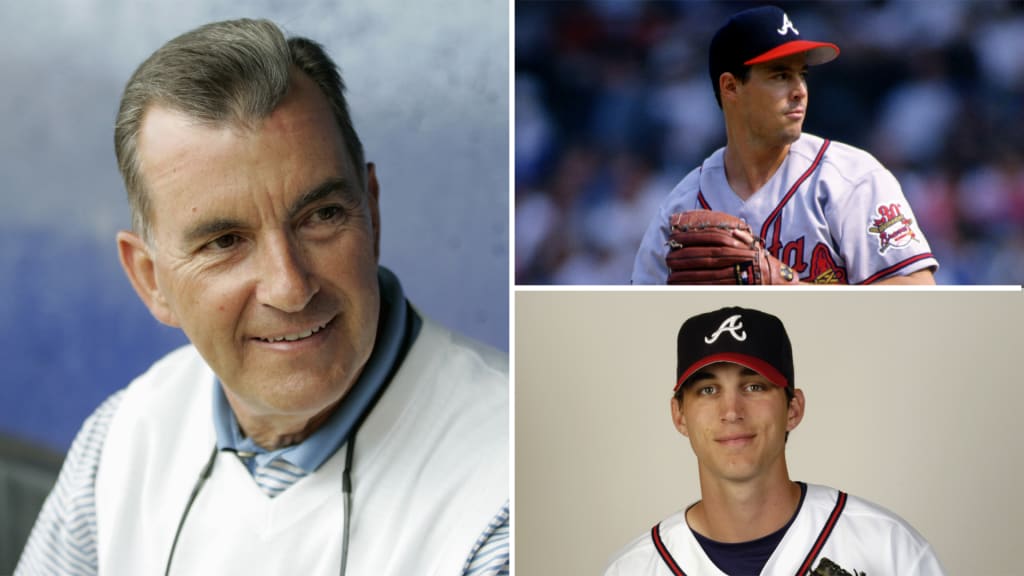
By bringing baseball’s top executives to the same location on an annual basis, the Winter Meetings have created an environment that has led to the completion of some of the most notable transactions in the game’s history.
Here is a look at the top five moves the Braves have made during the Winter Meetings.
1. Greg Maddux signs in 1992 (Louisville)
Nearly 30 years later, the Braves signing Maddux remains one of the most significant free-agent acquisitions in baseball history. It’s also one of the most intriguing when you account for the fact it wouldn’t have happened had the Braves indeed acquired Barry Bonds like they thought they had during the previous Spring Training.
The backstory focuses on two Hall of Famers: John Schuerholz, who was the Braves' general manager, and Ted Simmons, who was the Pirates' GM. After reaching what the Braves viewed as an agreement, Simmons informed Schuerholz he couldn’t make the deal because Pirates manager Jim Leyland had become very irate when informed of it.
So maybe Leyland deserves some credit for the Braves landing Maddux, who won the last three of his four straight National League Cy Young Awards while pitching for Atlanta (the first was with the Cubs, in 1992).
Schuerholz traveled to Louisville for the 1992 Winter Meetings with the impression Maddux would sign with the Yankees. In fact, then-Yankees GM Gene Michael left the Meetings to show the pitcher around New York.
But on the final night of the Meetings, Schuerholz and then-Braves president Stan Kasten negotiated a five-year, $28 million deal with Maddux’s agent, Scott Boras.
As Kasten sat in a suite at the Galt House Hotel, Schuerholz was across the hall trading Charlie Leibrandt to the Rangers. Leibrandt’s $2.8 million salary had to be moved to make room for Maddux.
Maddux passed on the Yankees’ $34 million offer to join John Smoltz and Tom Glavine in Atlanta. The Braves won the 1995 World Series and captured two other NL pennants with the assistance of these three starting pitchers, each of whom is enshrined in the National Baseball Hall of Fame.
2. Adam Wainwright for J.D. Drew in 2003 (New Orleans)
As camera phones and social media became more prevalent during this century, baseball executives chose to seclude themselves far more frequently during the Meetings. But Schuerholz and then-Cardinals GM Walt Jocketty were not trying to hide on Dec. 12, 2003, when they shared a drink or two at the lobby bar within the New Orleans Marriott.
A little more than 12 hours later, the baseball world would learn this wasn’t just a casual conversation between two longtime friends.
Schuerholz returned to his suite after meeting with Jocketty, talked to members of his staff and ultimately decided to trade Wainwright, Jason Marquis and Ray King to the Cardinals in exchange for Drew and Eli Marrero.
After the trade was announced, two of Schuerholz’s top lieutenants expressed regret about giving up Wainwright, a 21-year-old top prospect from Brunswick, Ga. Nearly two decades later, many Braves fans are still haunted by this trade.
While Wainwright established himself as one of the most popular and successful pitchers in Cardinals history, Drew lasted just one year in Atlanta. The outfielder hit 31 homers and produced a 157 OPS+ while helping the Braves win a 13th consecutive division title.
But really the only thing Braves fans remember about this trade is that instead of seeing Wainwright create a feel-good story within his home state, Drew proved that Georgia roots weren’t enough for him to stick around for more than that one season.
3. The Dansby Swanson trade in 2015 (Nashville)
As folks prepared to find dinner within the massive Gaylord Opryland Hotel on Dec. 8, 2015, word leaked the Braves had acquired Swanson, who six months earlier had been taken by the D-backs with the first overall pick in the MLB Draft.
The deal had the Braves sending Shelby Miller and Minor Leaguer Gabe Speier to the D-backs in exchange for Swanson, Ender Inciarte and Aaron Blair. Critics immediately blasted Arizona for making what was considered a lopsided deal for Miller, who had finally started to meet expectations after being traded to the Braves for the 2015 season.
As Atlanta officials were at dinner during the hours after the trade was leaked, they began to get worried the D-backs were going to respond to the criticism by nixing it. The concern remained well beyond midnight, when former Braves executives John Hart and John Coppolella called media members to their suite to discuss the trade, despite it not yet being official.
Ultimately, the trade was finalized as it had been constructed. While Blair didn’t live up to his promise as a prospect, Inciarte won three Gold Glove Awards with the Braves and Swanson highlighted his seven-season stint with Atlanta by helping the Braves win the 2021 World Series.
4. The Dan Kolb trade in 2004 (Anaheim)
This was a very eventful week for the Braves. Before traveling to California, they essentially revealed they would not be re-signing Drew, who ended up with the Dodgers. The plan was to use the money to land Tim Hudson, who was at the forefront of the rumor mill during that year’s Meetings.
While the Braves did end up signing Hudson a few days after the Meetings concluded, their only significant transaction in Anaheim came via the decision to trade hard-throwing prospect Jose Capellan and Minor Leaguer Alec Zumwalt to the Brewers for All-Star closer Kolb.
While Kolb’s tenure in Atlanta was a disaster, this move was made simply to give Smoltz a chance to return to the rotation. Smoltz took advantage and solidified his Hall of Fame resume by posting a 3.22 ERA and earning two All-Star selections over the next three seasons.
With Smoltz and Hudson leading the rotation, the Braves won the last of their 14 consecutive division titles in 2005.
As for Kolb, he posted a 5.93 ERA and blew seven of his 18 save opportunities during what was his only season in Atlanta. The best memory came via a question by a former Atlanta coach, who said, “Do you guys [the media] also boo when Kolb enters the game?”
5. The Edgar Renteria trade in 2005 (Dallas)
Before revisiting this trade, it’s important to remember that Theo Epstein temporarily walked away from his role as the Red Sox GM about five weeks before the start of the 2005 Winter Meetings. As for Rafael Furcal, he ended his tenure with the Braves by agreeing to a deal with the Dodgers just before the event began.
Schuerholz’s search to find a new shortstop led him to his longtime friend Bill Lajoie, who was appointed to serve as Boston’s top baseball official in Epstein’s absence. Lajoie was part of Schuerholz’s front office in Atlanta from 1991-98.
As the Meetings were coming to a close, Schuerholz agreed to trade top prospect Andy Marte to the Red Sox for Renteria, who had produced a .721 OPS during a disappointing lone season with Boston.
While Marte never came close to living up to the expectations set when some considered him to be the game’s top prospect, Renteria earned an All-Star selection in 2006 and produced a .825 OPS (113 OPS+) during his two seasons with Atlanta.
Enhancing the memorable significance of this trade was the fact that it was announced as Schuerholz was preparing to leave Dallas’ Hilton Anatole and head to the airport. So he explained the deal while pulling his suitcase through the lobby. A few members of the Atlanta media corps took notes while walking alongside him all the way to his awaiting car service.
